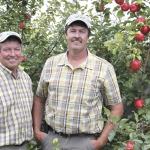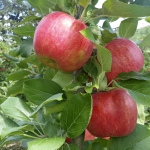It was a grand day in August four years ago when Steve Slaybaugh and his wife found ripe Honeycrisp apples in their Pennsylvania orchard. It was August 11, and apples on one tree were ripe—three weeks early.
“Why is that tree ripe?” Slaybaugh recalls saying to his wife, who was with him on a four-wheeler looking over the crop. They tasted it. “It’s ripe. It’s ready to pick,” he said.
Both quite excited about it, they took an apple home for son Dave to taste. They told their neighbor and good friend, Mark Rice, about it and asked his advice. He suggested they call Phil Baugher.
The next day, Rice called Baugher, president of Adams County Nursery—who was immediately interested.
“If we had a Honeycrisp that would ripen that early, it would be a pretty big deal,” he said. “Imagine if we can double the number of days in which we can harvest a good quality Honeycrisp.”
Slaybaugh still gets excited when he talks about it.
Until this year, the apple was kept pretty much under wraps.
“We haven’t shared it broadly with the industry,” Baugher said. “We had to propagate it and prove it would be true to type in the second generation. We saw the first fruit from the first second-generation trees August 11, 2012, and applied for a patent the next month.”
This year, Adams County Nursery and the Slaybaughs teamed up to show a group of growers and packers what the apple looks like—ripe on the trees, at four locations, on three days, August 13-15.
“This was not a closed meeting,” Baugher said. “We wanted growers to come and look—feel it, touch it, taste it, look at it. But there’s no sense in raising expectations too early. We don’t have the rootstocks available. We are booked up until 2017 like most U.S. nurseries. But growers who have rootstocks reserved with us can get this Honeycrisp selection budded on those rootstocks. Budwood is not as big an issue.”
The only “improvement” in this Honeycrisp is that it’s early, he said. Are there other differences?
“Not really,” he said. “It’s not redder, nor does it have less bitterpit or fewer production problems, as far as we know.”
“We had it tested and it’s a true Honey,” Slaybaugh said, “no less, no more, all the qualities of a regular Honey. There may be less breakdown, at least so far for us.”
While Baugher and Adams County Nursery were proving the new cultivar, the Slaybaughs and Rice, their neighbor, were taking advantage of their unique situation. About 40,000 trees have been planted—most of them, 14 acres each, by the Slaybaughs and Rice.
“For the five years we have observed it, it has ripened 20 or 21 days before Honeycrisp,” Baugher said. “For us in Adams County, Pennsylvania, that’s been August 12 to 16.”
The Slaybaughs’ fresh-market fruit goes to three Pennsylvania packers—Rice Fruit Company, Hess Brother’s Fruit, and Bear Mountain Orchards—for packing and sale.
Slaybaugh is pleased with his association with Baugher and Adams County Nursery. “Phil just took over,” Steve said. “He took care of all the patent application work. He budded the trees and began ramping up the budwood supply really quickly.”
The variety has been identified up until now as DAS 10, which stands for Dave’s initials and the arbitrary number 10. It is being released under the trade name Premier Honeycrisp (DAS 10 Cltv) and has been patented.
The Slaybaughs have entered into a commercialization agreement with Adams County Nursery, which has issued sub-licenses to Cameron Nursery, Eltopia, Washington, and Helios Nursery, Orondo, Washington. •








[…] the DAS10 apple. I am getting 36 trees in the Spring, a year ahead of the commercial orchards. An early Honeycrisp debuts | Good Fruit Grower __________________ John Deere 2305, 62" deck, &47" snowblower. SS1023B PTO driven […]